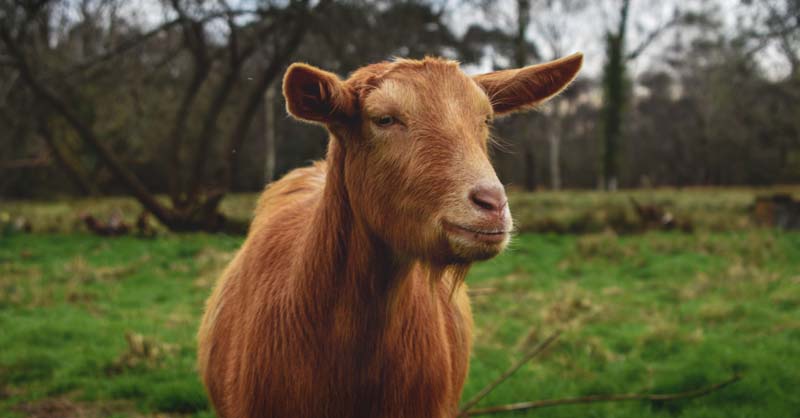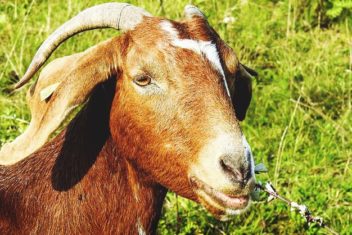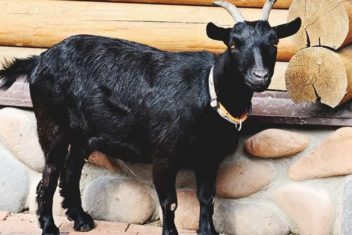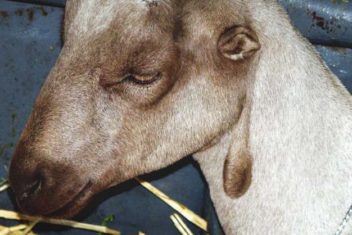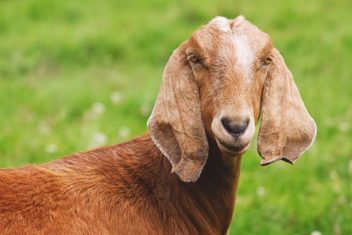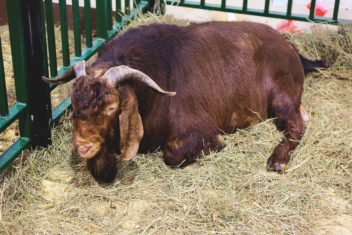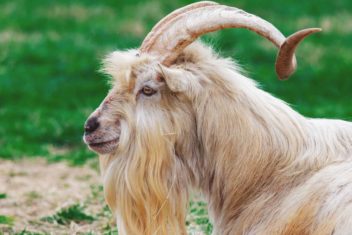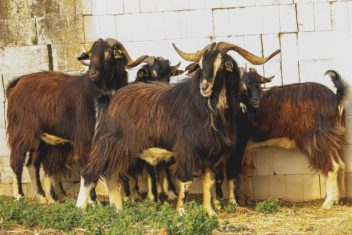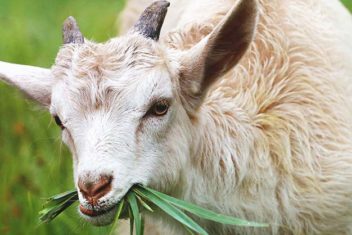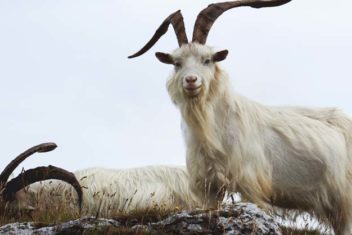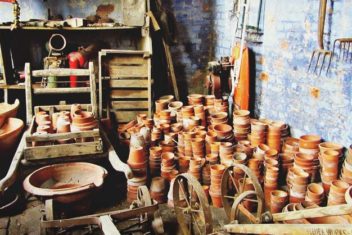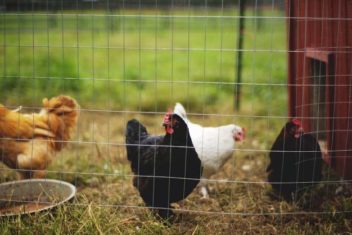“A Guernsey goat? I thought it was a cow!” If your thought process is like mine was when I first heard of Golden Guernsey dairy goats, you might be surprised to learn about this rare yet remarkable dairy breed.
Golden Guernsey goats are named for Guernsey Island, located in the English Channel. For about a hundred years these feral goats flourished on the island conforming the breed characteristics they have today.
Golden Guernseys are a new U.S. breed; the first Golden Guernseys goats were embryos implanted in Spanish goats in the late 1990s. Importation laws prohibit Golden Guernsey stock from being brought to the U.S. meaning there are very few here.
Nonetheless, Golden Guernseys have the potential of being a great homestead goat due to their excellent milk efficiency and size.
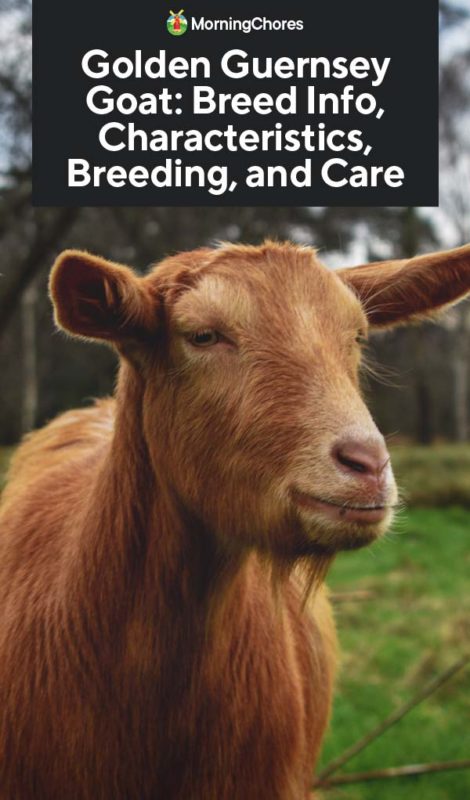
Breed Standards of the Golden Guernsey Goat
Golden Guernsey goats are beautiful animals. Unlike the common dairy breeds, they have long flowing coats, “bonnet” shaped ears, and a gorgeous, deep honey color.
Guernsey Goat Breeders of America (GGBoA) are the registry for Golden Guernsey goats. The main dairy registry – American Dairy Goats Association – does not yet offer registration but they do recognize the breed and have guidelines in their herd book.
1. Height and Weight
Golden Guernseys are considered a medium dairy breed. Bucks average about 150 lbs. and 28″ with does coming in at about 120 lbs. and 26″ tall.
2. Color
Golden Guernseys must fulfill their name and be gold in color. They can be any shade of gold though, with white roan patterns which are acceptable. It is also desirable for their coats to be long with a “skirt” but this is not required.
3. Other Breed Specific Standards
Other breed standards for Golden Guernsey goats include straight or dished noses, erect ears that are in the “bonnet” position when viewed from the side, and the same body condition and conformation as required for all dairy goats.
4. Golden Guernsey Breeding-up Program
Since the American stock of Golden Guernseys is so small, Golden Guernsey goats in America are being “bred-up”.
This means Swiss does (called foundation does) are artificially inseminated with a British Guernsey buck or a purebred Golden Guernsey buck from the one American herd in New York.
According to the GGBoA, each succeeding generation is then bred back to a purebred Golden Guernsey or British Golden Guernsey. Each generation must meet the breed requirements to preserve the unique characteristics of the Golden Guernsey goat breed.
When searching for Golden Guernsey goats it is important to do your research. Make sure you understand the breeding-up program and choose a breeder based on that knowledge.
Better yet, find a mentor. Another breeder can offer invaluable advice as you choose stock for your Golden Guernsey herd.
Typical Characteristics
1. Dairy Production Details
Golden Guernsey does give 10-12 lbs. of milk daily at peak production. They do have higher butterfat (between 6-8%) content making Golden Guernsey milk excellent for homemade dairy products.
Though Golden Guernseys produce less milk than an Alpine or LaMancha, they are amazingly efficient producers. They thrive on forage, requiring little to no grain, and commonly produce up to 10% of their body weight in milk.
For homesteaders with low acreage or desiring low-grain animals, Golden Guernseys fit the bill nicely.
2. Hardiness
Golden Guernsey’s hardiness is two-sided. Their wild island ancestry makes them more adaptable to different climates and resistant to parasites.
On the other hand, Golden Guernsey goat breeders need a good vet. Golden Guernseys do not have the immunity to our diseases as American breeds have, making a vet knowledgeable about goats a must.
3. Temperament
Compared to other dairy breeds, the Golden Guernsey goat needs more human interaction and solicitation. Remember, they were once feral goats. Their friendly side can be developed but it takes patience and time.
Breeding Golden Guernsey Goats
1. Maturity
Like other dairy goats, Golden Guernsey doelings need to be about 80 lbs. or 8 months old when bred.
Bucklings reach breeding maturity much faster and should be removed from does and doelings when about 4 months old. Despite this early age, it is best if they are at least 7-9 months old before they are trusted as a reliable sire.
2. Mating Season
Dairy goats are seasonal breeders. Typically this season starts in August and runs until December but it does vary according to when cooler temperatures start for your region.
Once the breeding season begins, a Golden Guernsey doe will cycle every 18-21 days until she is bred or temperatures turn cold in the early winter.
3. Kids
Golden Guernsey does carry their kids for 150 days or about five months. They can give birth to 1-3 kids and are good mothers.
It is best to keep kids warm and dry until warmer temperatures return in the spring.
Golden Guernsey Goat Care
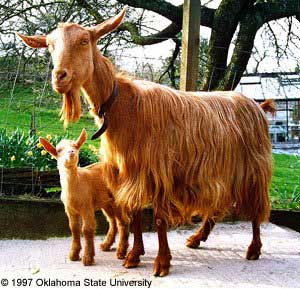
1. Feeding and Nutritional Needs
Golden Guernseys are very efficient foragers. This is why homesteaders with limited acreage are turning to the Golden Guernsey goat.
If methods such as rotational grazing and no-grain livestock are important to you, Golden Guernsey goats are your friend.
In addition to fresh forage, Golden Guernseys still require goat essentials such as clean water, quality hay, and free access to minerals.
2. Housing and Fencing
Goats need shelter from wind, rain, predators, and extreme temperatures. A barn or draft-free loafing shed serves them well.
Goats are also master escape artists. A sturdy fence such as cattle panels or three-strand electric wire will keep them where they belong and your neighbors happy.
3. Health Issues and Care
One disadvantage with any new breed is they have no immunity to our diseases. We can hope succeeding generations will improve the hardiness of Golden Guernseys but in the meantime, a good vet is your best friend.
Parasites are also a big concern with all goats. Prevention methods such as intensive grazing methods, immune system support, and a good deworming schedule form a strong arsenal against both external and internal parasites.
4. Grooming
Goats are tidy, clean animals. However, there are a few basic grooming needs that will make both yours and their life easier.
– Hoof trimming
Golden Guernseys hooves need to be trimmed every 4-6 weeks. To trim hooves you will need goat or sheep hoof trimmers and a hand-held wood shaver to smooth the hooves when you are finished. A milking stand or head shoot is also helpful but not necessary if your goat is trained to stand still.
– Udder Hygiene
Good udder hygiene is essential for pleasant-tasting goat milk.
Shaving a doe’s udder and underbelly will keep your milk cleaner and make it easier to hand milk. A sturdy pair of dog grooming clippers and blades will do a great job.
You will also need to groom your Golden Guernseys coats if they are long-haired. Trim the “skirt” short enough not to catch briers and brush, but yet long enough where they still have their glory.
– Bathing
Most of the time, goats tend to their own cleaning needs, but the longer coats of the Golden Guernseys need bathing more frequently than some breeds. Simple water and soap, followed with a good combing will do wonders for their salon needs.
– Show Grooming
Golden Guernseys are beauty queens for the show ring. Special grooming may be in order for you to bring out their best look in the ring.
5. Training
Golden Guernsey goats are more cautious, making it important for you to train them as young kids. Always be gentle and patient when training Golden Guernseys and they will learn to trust you.
Below are different kinds of training that will be useful with Golden Guernseys.
– Milk Stand Training
The best time to train a doe to a milk stand is when she is still very young. Even doelings can be lead onto the stand and fed on it to give a positive connection. Training the first-time milker takes some time and patience, but a gentle hand and a bucket of feed perform wonders.
– Lead Training
Again, the younger you train Golden Guernseys to a lead rope, the easier it will be – for both of you! Slip the lead loosely around their neck and lead them in short, low-pressure sessions.
– Show Training
The best way to prepare Golden Guernsey goats for the show ring is to practice like it is the real deal. In showing, goats have to stand and walk on command. Learn the various postures required in the show and make your buck or doe as comfortable performing as possible.
Alternative Breeds
Oberhaslis are a breed that is similar in size to Golden Guernseys but gives more milk, producing about 2 gallons a day. Their butterfat is lower but if you want a beautiful goat that is a great producer they might be up your ally.
Did You Know?
Miss Miriam Milbourne is credited with saving the Golden Guernsey goat in 1924. It is largely through her noticing and preserving the breed that we have them today.
With patience and determination, she grew her herd to about 30 goats and it was shortly after this that the Golden Guernseys were imported to England.
Conclusion
Golden Guernseys are a rare breed with impressive potential. Homesteaders would be wise to keep this gorgeous goat on their radar for their milk efficiency and potential hardiness.
Beautiful color, homestead friendly, and a name with a kiss of Old World romance – yes, the Golden Guernsey dairy goat has the makings of an enduring American breed.
Special thanks to Sara Dzimianski with the Guernsey Goat Breeders of America for her invaluable help in researching the Golden Guernsey goat!
